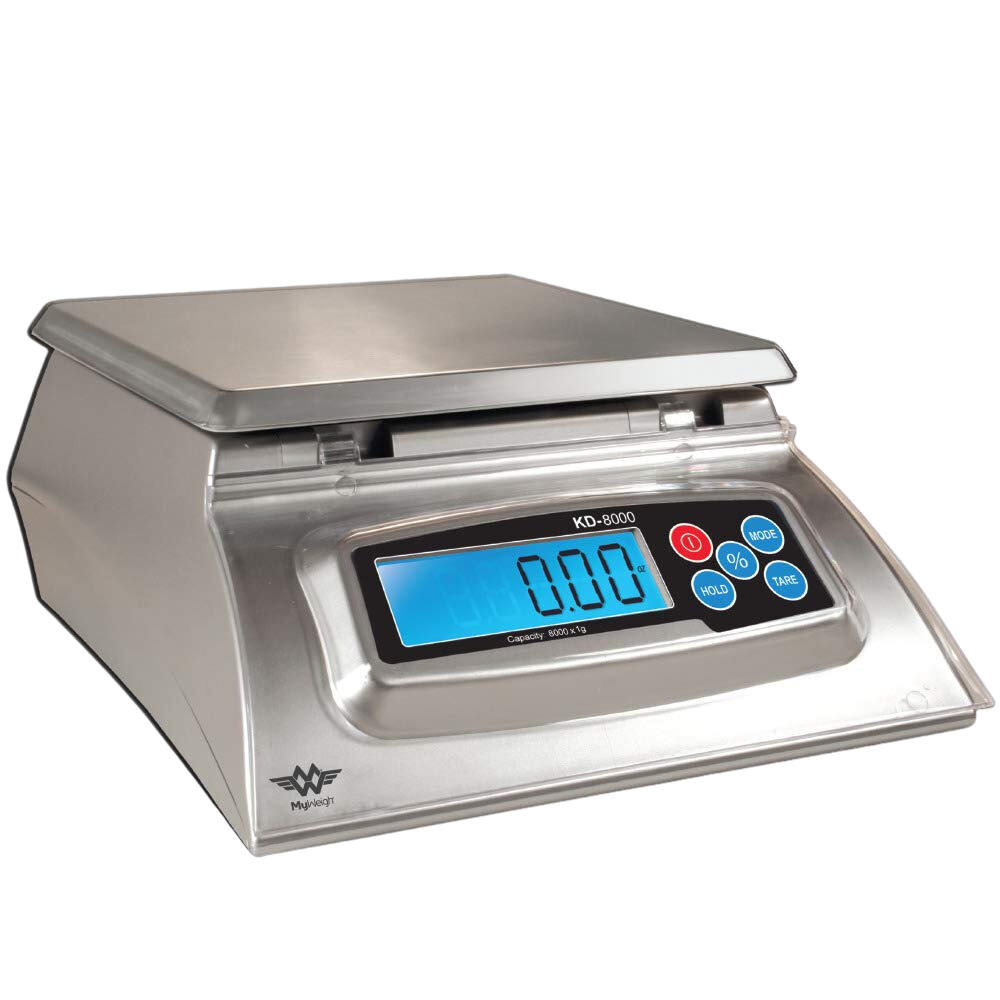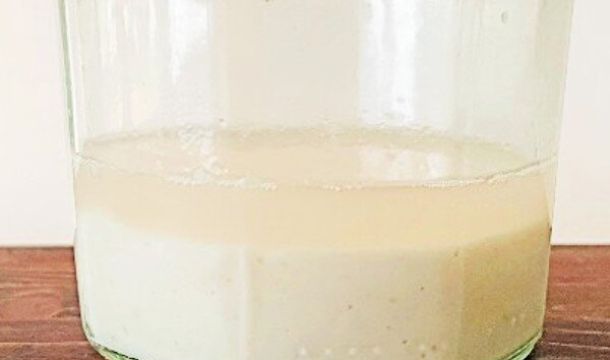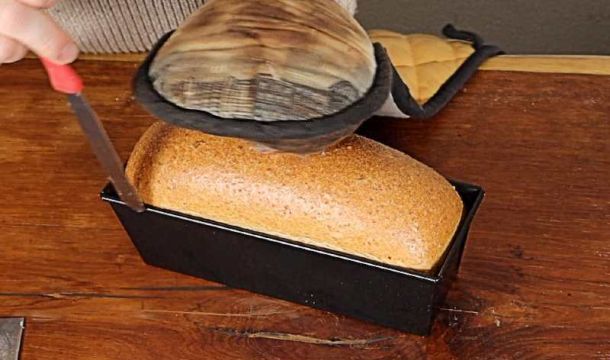
How To Fix A Dry Dough – Tips For Kneading Bread

Isn’t it funny when your dough turns out dry and crumbly when kneading it? Well, perhaps not funny, but it is a challenge you’ll have to endure at some point if you make bread regularly!
Arriving at the perfect liquid-to-flour ratio is a challenging skill that recipe books make look easy. But as you’ll learn in this post, there are many reasons for bread dough to turn out dry.
Fortunately, there’s a simple solution to fix a dry dough!
How to fix a dry dough?
Start by adding an extra 1-2% of water. By this, I mean if 50 grams/ml were originally added, add 5-10 grams. Then knead for a minute until absorbed. If you need more, add another 5-10 grams.
Repeat until you’ve formed the cohesive dough you are aiming for.
How to know when dough is too dry?
If you think your dough is too dry, it probably is – but hang on for a few minutes to read this before adding water!
Some bread doughs are intentionally dry and hard. As kneading continues, the dough softens, and a firm yet workable dough is created.
On the other side, many bread doughs require a wetter consistency. So what does too dry and too wet look like? First, you have to be sure you are targeting the correct consistency…
Recipes that require a firm dough:
A stiff consistency means that the dough can be moulded into perfect shapes and goes on to retain its shape as it rises.
Bread recipes where less liquid is required include:
- Soft and crusty rolls
- Challah
- Brioche
- Sweet breads, such as Chelsea and Belgian buns
- Tin bread
- Bloomers
Note that these breads contain a healthy amount of fat (or not quite healthy for health reasons). Fats soften the crumb structure, preventing the bread from being dry.
Recipes that require a wet dough:
Many types of bread that are baked at home require more water. These include:
- Sourdough
- Baguettes
- Campaillou
- Finger (bridge) rolls
Recipes that require a high-hydration dough:
A small group of bread types require a very wet dough. These varieties include:
- Ciabatta
- Foccacia
- Pannetone
The majority of other recipes require a viscosity somewhere in between.
When is a firm dough too firm?
A firm dough will feel dry and incohesive to begin with. Adding water during the early stages of kneading is tempting to make it more luscious, but this can be a mistake.
Adding unnecessary water can lead to it being too wet.
Instead, continue kneading and only add extra water if the texture resembles a dry crumble mixture, feels as hard and heavy as stale bread and is very hard to push together.
Whether you add water during the early stages of kneading or not, if it’s still too dry after 5-10 minutes, you can always add water at this point.
TIP: Extra kneading is required when water is introduced later during kneading.
When to add more water to a medium-hydration dough?
If you want your dough to be softer so it develops longer gluten strands and an open crumb, add water at the earliest moment.
Kneading dough that’s under-hydrated causes damage to the gluten strands. There is also the bassinage technique, which delays a portion of the recipe’s water until the end of kneading to produce a more open crumb.
So it’s always best to add water to a dough as soon as possible.
In the early stages of kneading, I work by the “if there are dry bits and wet bits, we’re ok” rule. By this, I mean if it feels slightly wet, but plenty of dry flour is not incorporated, it should be ok.
Yet, if you see dry flour/flakes not being absorbed into the dough or dough that crumbles instead of stretching, you have a dry dough that needs fixing.
With experience, this consistency becomes easy to understand and correct early if an imbalance exists.
So, when you’re in the early stages of kneading, and the dough feels too firm and dry to be able to bond into a smooth consistency, add some extra water.
When to add more water to a high-hydration dough?
When the dough is supposed to be extra wet, you will want to add more water when the dough feels slightly firm. Wet bread doughs are commonly used when following a double-rise method.
The double-rise method
If you are including a bulk fermentation period and a proofing stage to your bread dough, you are following a double-rise method (see: Can I make bread without rising twice?).
Dough naturally firms during the first rise, and a more robust gluten structure develops. These factors mean that a less rigid structure can be supported, and you can be more liberal with adding water.
Why is your bread dough dry?
Bread dough becomes too dry because there is not enough water. The flour-to-water ratio is incorrect, whether by accident or an untested recipe. Common reasons for this are:
Too much airflow
If you’ve left your dough sitting on a workbench or bowl near an open window, then moisture will be picked up by the current and leave the dough.
Although draughts are unlikely to be the leading cause of dry dough, they will make it drier. Always cover your dough when resting and away from draughts.
There was too much flour
Maybe you read the recipe wrong? Maybe the recipe used a different flour than the one you are using? Or, perhaps you used measuring cups for your ingredients?
To avoid mistakes, try to use recipes written in similar climates to yours, ditch the measuring cups and use scales to weigh your ingredients.

MyWeigh KD8000 Digital Food Scale
If you want to take your bread baking to the next level, a decent set of scales is a must!
The My Weigh KD-8000 Digital Food Scale is the perfect scale for bakers. It’s durable, fast to turn on, VERY responsive, and most importantly, has chunky buttons that are easily pressable when you’ve got dough on the go.
The My Weigh KD-8000 is a new version of My Weigh’s top-selling kitchen scale, updated with baker’s math and percentage weighing.
Using a very-high protein flour
The right type of flour makes a big difference to your dough.
Bread flour has a higher protein content than all-purpose or pastry flour.
Protein absorbs water better than other components of white flour. Therefore, high-protein flour will require more water than lower-protein flour to prevent the dough from turning out dry.
Whole grain flour
Whole wheat and other whole grain flour contain bran and often more protein. These particles are water-soakers, which means your dough will need more water than a white bread recipe.
Bran is also slow to absorb water, so it’s common to notice that whole wheat dough becomes dry after the first rise.
Seeds and dried ingredients will also soak up water in your dough, so I recommend preparing a soaker to avoid dry dough. An alternative is to autolyse your flour.
Too much sugar/salt
Sugar and salt absorb water, which means there is less available for the dough. High quantities of these ingredients slow yeast activity and lead to a dry dough.
Note: Instead of water, you can add another liquid such as egg, vegetable oil or milk
Burning your mixer
If you are kneading dough using a stand mixer, and you start to smell burning from the motor, or worse still, it trips out, stop! The dough is too firm for the mixer, and you are overloading it!
You’ll need to soften the dough or remove it from the mixer and knead by hand.
NOTE: Gluten soaks up water more than starch, meaning high protein flour requires more water than a lower portein variety.
How to fix a dry pizza dough?

Pizza dough is quite dry dough. Neapolitan pizza dough has a dough hydration of around 63% and uses flour with a reasonably high protein quantity.
If your pizza dough is cracking and the dry bits won’t incorporate into the dough, you’ll want to add more water.
Like with bread dough, if your pizza dough is too dry, add around 1-2% of the weight of the water you initially added and knead until combined. Repeat until the dry flour particles are hydrated.
How to fix dry dough after rising
If your dough has dried out during the rising process, it’s not a disaster!
All you need to do is get a water mister, give the dough a good spray and wait 5-10 minutes for the water to be absorbed.
If you don’t have a water mister, brush on the water with a pastry brush or your fingers.
To learn more, see how to rehydrate dough.
So, how do you fix a dry dough? – Conclusion
All you have to do is add a little bit of water at a time to fix a dry dough. I recommend you note how much water you added to amend the recipe and avoid the guesswork next time you bake. It’s much easier this way!
There is a similar process for fixing wet bread doughs. Follow the link to learn more!
I hope you’ve found this post helpful. Let me know in the comments below how this technique works for you!
If you’ve enjoyed this article and wish to treat me to a coffee, you can by following the link below – Thanks x
Comment
Leave a Reply Cancel reply

Hi, I’m Gareth Busby, a baking coach, senior baker and bread-baking fanatic! My aim is to use science, techniques and 15 years of baking experience to make you a better baker.
Table of Contents
- How to fix a dry dough?
- How to know when dough is too dry?
- When is a firm dough too firm?
- When to add more water to a medium-hydration dough?
- When to add more water to a high-hydration dough?
- Why is your bread dough dry?
- Burning your mixer
- How to fix a dry pizza dough?
- How to fix dry dough after rising
- So, how do you fix a dry dough? – Conclusion
Related Recipes
Related Articles
Latest Articles
Baking Categories
Disclaimer
Address
53 Greystone Avenue
Worthing
West Sussex
BN13 1LR
UK








I live in South Africa and make bread for Teniqua Treetops lodge, and about a year ago was asked to make pizza dough. I only use Eureka stone-ground flour. I tried all bread flour–too crisp, chewy, and heavy, I tried half cake half bread, then I tried the closest to AP flour ratios as I can get, still too crisp, it cuts one’s mouth.
I don’t have a pizza wood oven, so I use my gas oven. I then tried 00 flour, still too crisp and heavy. I tried half bread half 00, half cake flour half 00, tried the AP ratio with half 00, still no luck. They also want thin pizzas, which is good, because the thicker one was too chewy, I guess because of the bread flour.
Then I was given a store bought pizza they liked, which was nice and crispy, but not too crispy like mine, and I noticed the crumb was quite biscuity, something they preferred. I tried all cake flour ro see if I could get the biscuity texture, still no luck. I tried using milk or butter or oil and still couldn’t get it right. I’m at a loss as to how to get the biscuity crust that is still crisp, but doesn’t cut one’s mouth.
I’ve tried pre-cooking the pizza for 3 min and it bubbled beautifully, then I put on the toppings and cooked it until the cheese melted about 8 – 10 min, but it’s still too crisp.
I tried a wrap recipe, but it that’s not crispy enough.
I won’t lose my job because I can’t get it right LOL, the lodge belongs to my family, but I really want to get this pizza dough right. I love developing new dishes, so this trial and error gig isn’t new to me, but it has become frustrating and I’m out of ideas. Please help if you can.
Thank you. I love your blog.
What you’re trying to make is quite difficult!! It will be hard to get the balance between the crust you want and the topppings to brown at the required level using a gas oven. Nethertheless, you should be able to get that biscuity texture by making your pizza dough really quickly:
-Knead for 5-10 minutes so the dough is well developed, but not at the windowpane stage. The dough should be firm and fairly dry. Divide the dough into peices, leave to rest for ten minutes, flatten, add toppings and bake.
Reducing the rising period to next to nothing prevents the gluten from fully developing.
Add vegetable oil to your dough to make it less crispy. A little bit of sugar can help tendorise too. Not sure whether AP or bread flour will be best for your situation.
Hope there is something here to try. Good luck with it and I’m glad you won’t loose your job about it! ha
I just started using a Stoneground organic bread flour and I cannot seem to get a decent loaf of sourdough bread. It won’t rise and at times I can’t get it to stretch, it breaks and crumbles. Is this because it’s whole grain and needs more water? The starter is very active, bubbly and “breathing”. Also the flour is darker in colour.
Stoneground whole grain is tricky. The extra bran it contains will get in the way of the gluten, and can tear the strands, giving you the results you are finding. It also has more enzyamic activity than roller milled. The simplest solution is to mix it 50-50 with white bread flour, but there are a few tricks you can utilise to get a better product without doing so.
-You can try soaking or autolysing the flour (click the link). This will soften the bran and enable your gluten to stretch.
-Like you say, add a little more water, especially if it looks like a crumble mix!
-Use slightly less starter and extend the first rise period
-Less kneading, followed by several stretch and folds across the first rise
Hope these tips help!
I’ve been making bread for about 50 yrs. started by hand then bread machine on dough cycle. last year while i was making cinnamon rolls at Christmas i noticed the rolls didn’t raise as high. make a recipe i’ve made for 30 yrs & it didn’t raise & was like a brick. used AP flour.i thot my machine was going bc i’ve used it a lot & its at least 15 yrs old. its a Zo. oh, BTW i bought new yeast. no help.finally decided to get a new machine.arrived on Mon. , a Breville. i’ve had 2 failures out of 2 tries.i used a recipe i’ve made for at least 10 yrs. so i know it works. 1st time i let it start & bake which i never do but wanted to see what happens..didn’t raise,dough very heavy, hard as a brick. i use bread improver & diastatic malt. i prefer SAF yest but used Fleishmans bread machine yeast bc its all the store had. today used same recipe on dough cycle. watched it mix & added a little milk bc it looks dry.it seemed to knead ok. i had to more lour out of corners. when it finished the dough was now smooth but heavy & not elastic. put it in bread pan to raise again & i let it sit until after dinner–about 7pm. very little raise. i don’t det it. can u help?
Have you previously used SAF gold yeast, or the red one?